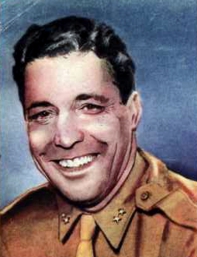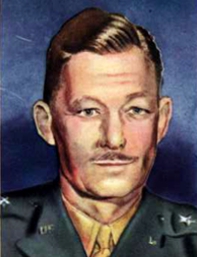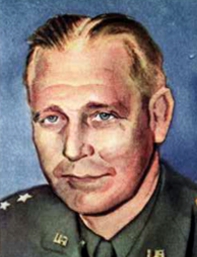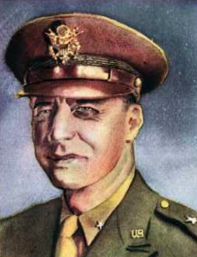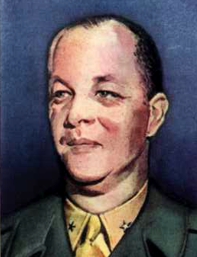A Brief Historical Survey
Bombing of the enemy's industrial targets and airfields on the Continent began almost at once. A little later fighters were used on escort duty for the mediums and for heavies from the neighboring Eighth Air Force. Operations and growth proceeded, although flying was somewhat restricted by reason of the foggy, rainy, English winter.
The Ninth Air Force was reorganized as a tactical Air Force. Mustangs, Thunderbolts, Lightnings, Marauders and Havocs were substituted for the original groups of Warhawks, Kittyhawks, Mitchells and Liberators, and, much later, Black Widow night fighters were added. The Force had a Troop Carrier Command with a large fleet of glider towing C-47's, some of which also served as freight-carrying and hospital planes. It had its own airdrome building engineers, and anti-aircraft brigades.

C-47 Skytrains were derived directly from the DC-3 commerical planes. To the left are Waco CG-4A gliders of the 439th TCG.
Combat elements of the Ninth were disposed over the south of England, with troop carrier bases as far north as Grantham in the Midlands. Many of the subordinate headquarters were in picturesque estates throughout the English countryside, which, in two years, had been transformed into a network of military airdromes and supply dumps.
A major assignment of the Ninth, in the pre-invasion phase was the day-to-day bombing of a large number of sites the enemy was constructing across the channel for the launching of flying bombs against London. To the Marauders and Havocs it was a race between construction and destruction on more than a hundred targets spread over the Pas de Calais. Commander of these bombers was the youthful Major General Samuel E. Anderson, under whose guidance the B-26 Medium was developed from an ineffective weapon to a scourge well worthy of the name, Marauder. As events raced toward D-Day, the Ninth's bombers, along with other Britain-based air forces, turned their attention towards targets more vitally concerned with the coming invasion. Coast defenses, inland strong points, marshalling yards and airfields were attacked, but bridges were the priority target.
They developed close support of ground forces almost to the final degree, and out of this evolved the destructive plane-tank team, inked by radiophone.
Bridges over the Seine and the Loire were relentlessly pounded, and practically all knocked out within the triangle formed by these rivers pointing toward Paris. Another valuable contribution to the planning of the invasion was made by the Ninth's photo and weather reconnaissance.
With the coming of D-Day eve, the Ninth's sky-trains formed a mighty armada to transport two divisions of airborne troops for the first Allied landings behind the enemy's Atlantic wall.

Over Germany a P-47D Thunderbolt A7-G of the 368th FG peels off to begin a strafing run on a German airfield loaded with aircraft.
Meanwhile all of the Ninth's fighter planes, released from defensive roles by the successful air war against the Luftwaffe, had been converted into dive bombers. After helping to cover the vast amphibious landings on D-Day, these converted fighters range ahead of the Allied lines dive-bombing and strafing trains, bivouacs, moving columns and fortified positions, almost un challenged by enemy fighters. They developed close support of ground forces almost to the final degree, and out of this evolved the destructive plane-tank team, inked by radiophone.
The Ninth shepherded the forces which quickly took Cherbourg and the whole of the Cotentin peninsula. They spearheaded General Patton's Third Army in its blitzkrieg dashes out over the Brittany peninsula, around and past Paris and across the Seine.
Just beyond the scope of close support, the mediums and the dive bombers blocked the enemy's routes of supply. They bombed and strafed escaping columns, when the Germans began their headlong retreat from Allied encircling movements.
Air Force engineers, meanwhile, kept pace with the rapidly shifting front by miracles of airstrip building. They altered landscapes almost overnight. They created long smooth runways which supported more traffic than the busiest bases in America.

Capt. Milton Marx subject is a 353rd Fighter Squadron Mustang having its guns boresighted. The description reads: MUSTANG "FIRING IN". Tail jacked up, plumb bobs hanging. Guns are checked in ths way.
The Air Force had completely moved its enormous establishment and satellite units by the end of September. It was spread over a wide area of France with its most forward elements in Belgium.
In August there were changes in command. General Brereton left the Air Force to become head of the First Allied Airborne Army, and Major General Hoyt S. Vandenberg took command of the Ninth. Major General Ralph Royce had come and gone as Deputy Commander, and General Straham moved up from Chief of Staff to Deputy Commanding General for Administration.
By the end of the month the ground forces, with which the Ninth Air Force was teamed, had driven the Nazis across their own boundaries. Africa had been the end of the beginning; this was the beginning of the end.

